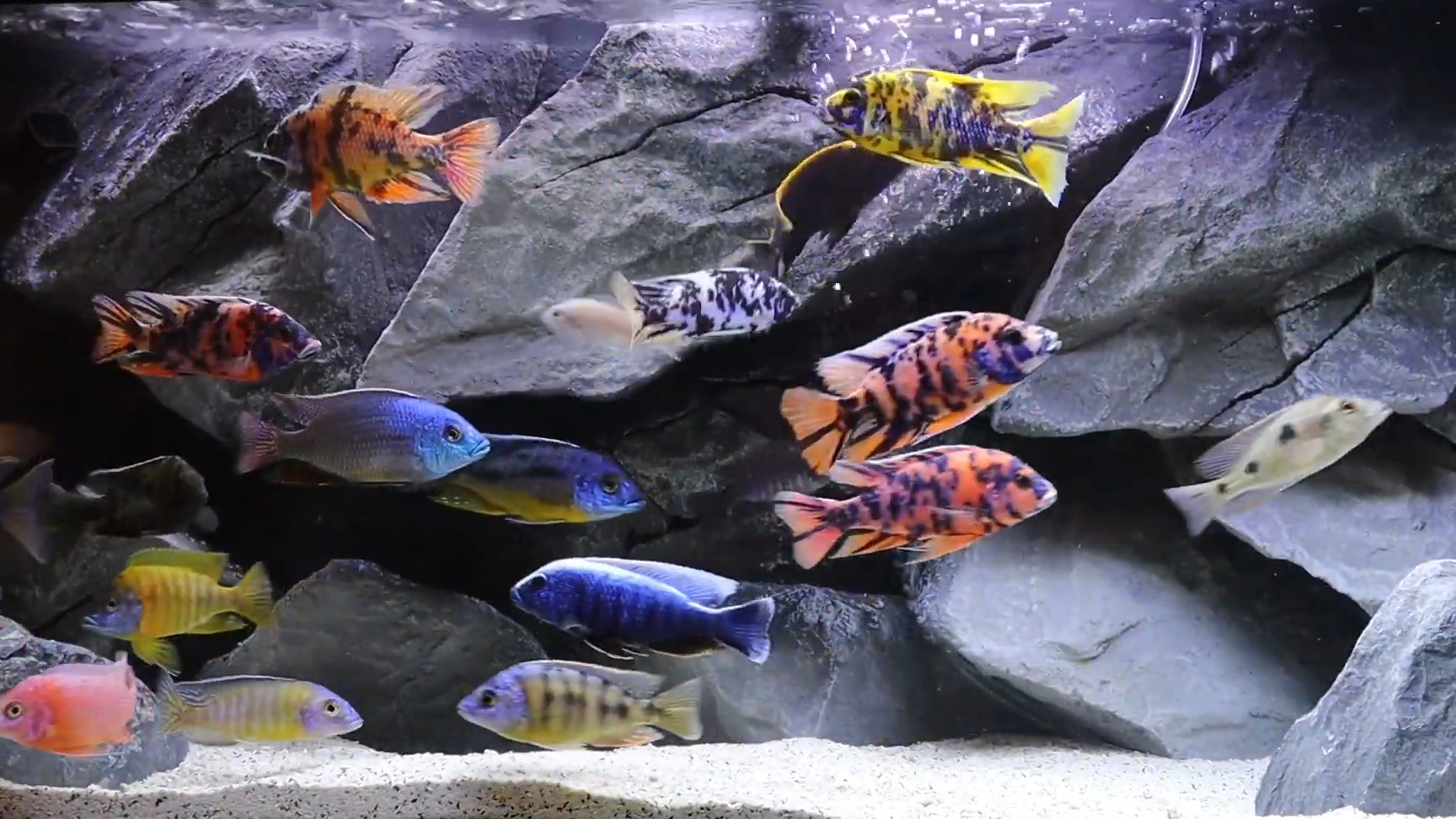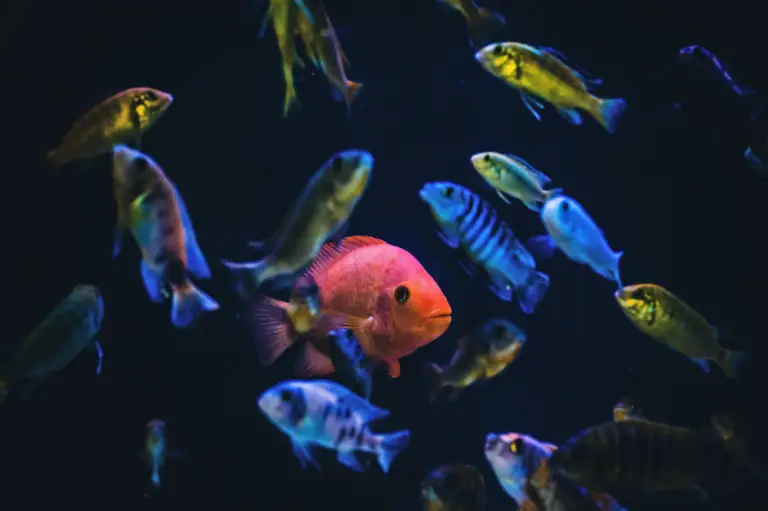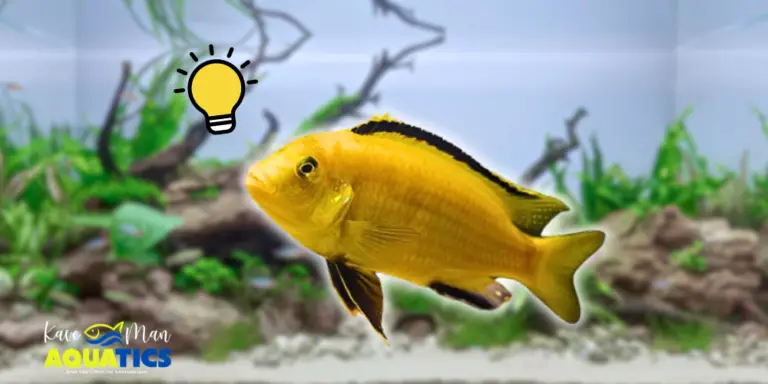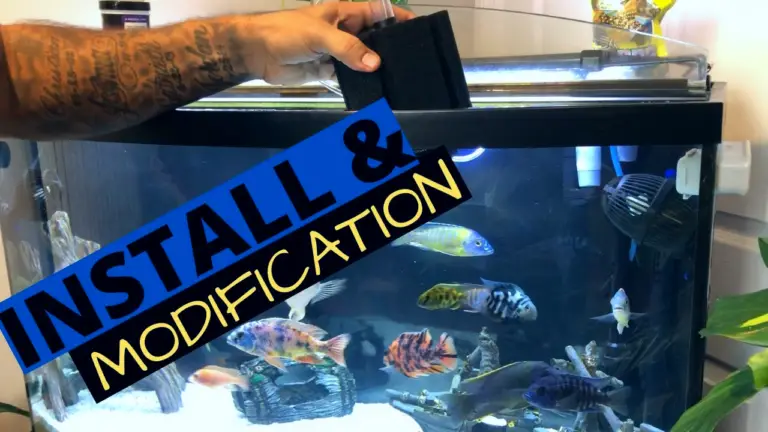A Simple African Cichlid Care Guide (5 Things You Must Know)
African cichlids may not be everyone’s favorite due to their aggression, but they make up for it with their beautiful colors and patterns. Chances are that once you buy a few African cichlids, you’ll add more to your collection.
But, before you buy any new fish, do your homework (this goes for both beginners and the experienced)! As they are part of the Cichlidae family, African cichlids are both beautiful and challenging to keep.
And that’s why we’ve created this African cichlid care guide for you. After reading this blog, you’ll know more about the proper care of these beautiful “beasts.”

African Cichlid Care Guide: Overview
| Family | Cichlidae |
| Scientific Name | Pseudotropheus |
| Species | Mbunas, Haplochromis (Haps), and Peacocks are the three genus groups with thousands of species under them |
| Common Names | African cichlid, African Lake cichlid |
| Location | Great Rift Valley, East Africa |
| Size | 2 – 12 inches (5.08 – 30.48 centimeters) |
| Life Expectancy | 6 – 10 years average (in captivity) |
| Appearance | Wide range of body shapes, but generally, they have are ovate in shape, and slightly laterally compressed |
| Color | Various colors, from blue, yellow, pink, green, red, and purple, with spots or stripes |
| Diet | Herbivorous, omnivorous, carnivorous, insectivores – depending on the species |
| Behavior | Semi-aggressive or aggressive – depending on the species |
| Tank Size | 55 gallons (208.1 liters) or larger |
| Temperature | 78 – 84 °F (25.5 – 28.8 °C) |
| pH | 7.8 – 8.5 |
| Water Type | Freshwater |
| Hardness | Hard, 12–30 dGH |
| Care Level | Moderate |
| Breeding | Difficult |
Natural Habitat
The various African cichlid species can be found in the three East African lakes: Lake Malawi, Lake Tanganyika, and Lake Victoria.
Their natural habitats have warm, clear waters with sandy substrates and lots of vegetation. Most African cichlids live in the shallows of their habitats, scavenging for food.
When building a cichlid tank, it is critical to understand each species’ natural habitat in order to replicate it.
Appearance
It’s no secret that African cichlids are a diverse fish group that comes in a variety of sizes, colors, patterns, and fin styles. In general, most are ovate in shape, and their bodies are slightly laterally compressed – giving them a torpedo shape.
Here are just some of the most common types of African cichlids, and their appearances, listed below:
- Peacock cichlids: Bright yellow, red, blue, gold, or purple bodies.
- Zebra cichlids: Black and white striped bodies with several color variations such as blue, orange, red, and yellow.
- Electric blue cichlids: Vibrant blue, iridescent bodies with paler heads than bodies.
- Electric yellow cichlids: Bright yellow coloration with whitish-yellow bellies.
- Mbuna cichlids: Blue, yellow, or orange bodies with horizontal black stripes on the head and vertical black stripes on the body.
It’s worth noting that male African cichlids are more vibrant than females, especially during the breeding season. When water conditions are poor, their colors become duller. So yes, African cichlids can change colors.
Behavior
African cichlids are infamously known for their aggressive and territorial behavior. These fish follow a hierarchy; meaning that one fish will be the “tank boss.” – he’s the guy that does the chasing and nipping (showing his dominance).
If they show too much aggression, we have a few tips for you to keep your African cichlids from killing each other.
They’re very active fish, to say the least. So they need ample swimming space as well as lots of hiding places to claim as their territories.
Being diurnal fish, African cichlids are more active during the day than at night.
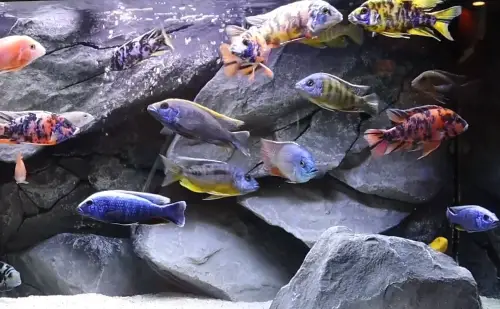
Tank Requirements
Please ensure that before adding any new fish to a tank, it’s properly cycled. That’s where a quarantine tank can be very valuable.
| Tank Size | 55 gallons (208.1 liters) or larger |
| Temperature | 78 – 84 °F (25.5 – 28.8 °C) |
| pH | 7.8 – 8.5 |
| Water Type | Freshwater |
| Hardness | Hard, 12–30 dGH |
| Substrate | Sand, pebbles, rocks (they are foragers) |
| Filter | Yes, a filter is required as African cichlids produce a large amount of waste and stir up the substrate. They don’t do well in tanks where nitrogen levels are spiking or unstable. |
| Plants | Optional, live plants can supply oxygen, reduce Nitrates, and complement African cichlids’ colors. |
Tank Size
Bigger is always better. It’s best to start off with a tank size of 55 gallons (chances are that you’ll add more fish to your collection).
Tanks with wider footprints are better than tall, narrow tanks because they offer more bottom area for fish to occupy. A general rule of thumb is 5 gallons per 1 fish.
Temperature
The ideal temperature for African cichlids is between 78 – 84 °F. In the wild, they live in the warm tropical water of lakes in Africa. Take note that warmer water’s ability to hold oxygen is lower – make sure that your tank is well aerated.
Keep in mind that most aquarium plants don’t do well with higher temperatures. Hardy plants such as bucephalandra, anubias, and java fern can be used.
pH and Hardness
African cichlids prefer hard, alkaline water. The pH levels can range from 7.8 – 8.5 and the GH can range from 12–30 dGH. The exact value would be subject to the species you want to keep.
Test the water parameters frequently to ensure you maintain a healthy and thriving environment for your fish. We have an article explaining exactly what aquarium pH, GH, and KH are.
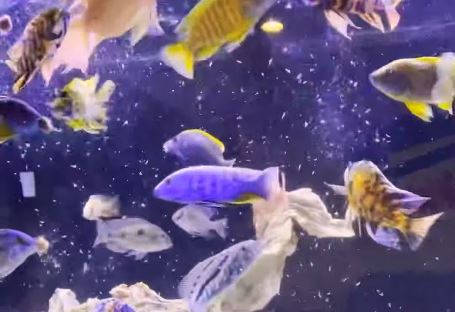
Diet
In the wild, African cichlids eat a largely carnivorous diet, but they are opportunistic eaters – eating whatever they come across such as plants, insects, and small fish. It’s worth noting that some species can be carnivores, herbivores, omnivores, or insectivores.
Captive African cichlids can eat foods such as flakes, insects, blood worms, frozen foods, cichlid pellets, algae waters, brine shrimps, vegetables, and even fruits.
Food that sinks to the bottom is ideal for these scavengers as they enjoy sifting through the sandy substrate.
In general, the amount of food should be enough for them to finish within 1 – 3 minutes, feeding them 1 – 3 times a day. Give longer gaps between meals to give their digestive systems some time to clean (and to keep your tank clean).
Tank Mates
African cichlids are territorial and tend to be more aggressive. It’s recommended to have confident, fast-swimming tank mates that can live in the same environment.
| Best tank mates for African cichlids | Worst tank mates for African cichlids |
|---|---|
| Other, similarly-sized African cichlids | Fish with shy, peaceful, and docile temperaments |
| African catfish | Fish that are smaller and naturally less aggressive, non-territorial (happy-go-lucky) |
| Plecos | Angelfish |
| Red tail sharks | Discus fish |
| Rainbow sharks | American cichlids |
| Zebra loaches | Dwarf Cichlids |
| Giant danios |
Do note that it may be best to keep an all-male tank of African cichlids as the addition of females will increase aggression levels – especially when it’s breeding season.
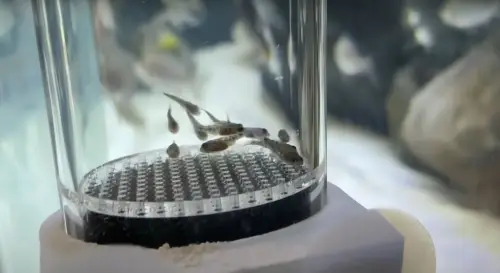
Breeding
Some African cichlids lay their eggs in caves and then guard the eggs until they hatch, whilst others are mouthbrooders, which means the females hold the fertilized eggs in their mouths until the eggs hatch.
When trying to breed African cichlids, you’ll need to have a male and female in the same tank by themselves. For optimal breeding odds, the layout, furniture, and size of the tank must not be changed during this process.
With a separate growing tank, you can expect more surviving fry that would grow beautifully and fill your next tanks.
The incubation period can last between 21 – 31 days, depending on the water conditions. Once hatched, the free-swimming fry is released but the mother would collect them again once they’re threatened. Males would typically harass the female after spawning.
Conclusion
We hope you found this article reassuring in your African cichlid ventures. The main takeaway from this fish care guide is to reduce aggression levels and maintain optimal water conditions.
Many new African cichlid owners may fixate and worry too much about these beautiful “beasts” but stay calm and follow this care guide. We have numerous articles covering most aspects of caring for African cichlids.
KaveMan Aquatics also offers an online video course, Keeping African Cichlids. If you feel that that’s not enough, we also offer 1-on-1 consulting services for that personal touch.


